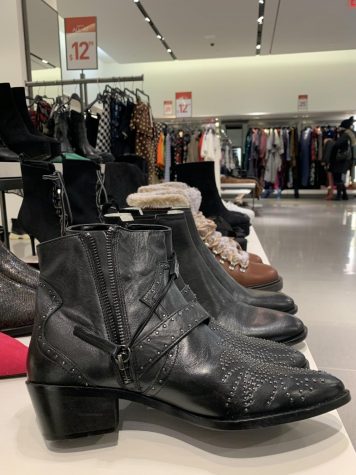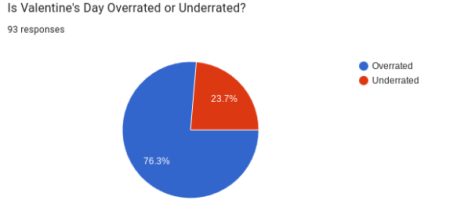Fast Fashion: The Real Cost of Cheap Clothes
February 12, 2020

These are the fashions displayed at the Zara store in Woodfield Mall. Zara is a brand that has become synonymous with the fast fashion trend– quick turnovers, knock-offs and affordable pricing– has spelled out success for the Spanish company and others that follow a similar business model.
Fast fashion defined:
inexpensive clothing produced rapidly by mass-market retailers in response to the latest trends. ~According to Oxford English Dictionary
The term was used as early as 1989 when the New York Times covered the entrance of the stores Compagnie Internationale Express (now known as Express) and Zara into the American market in the article “Two New Stores That Cruise Fashion’s Fast Lane” by Anne-Marie Shiro.
“One shop has a faux French accent and the other a real Spanish one, but they both speak the same fashion language. It’s a language understood by young fashion followers on a budget who nonetheless change their clothes as often as the color of their lipstick,” Shiro stated in the article.
The term continues to describe the advent of mass-production brands that release new collections numerous times in one traditional fashion season. These companies offer customers an affordable way to emulate trends from social media and the runway.
———-
People are becoming more aware of their impact on the environment than ever before– some changing their lifestyles drastically to shrink their carbon footprint and reduce waste. What most don’t realize, though, is that evidence of harm to the planet can be found in their own closet.
The manufacturing of clothing is responsible for 20 percent of wastewater and makes up 10 percent of global carbon emissions– more than maritime shipping and international aviation combined, according to the UN Environment Programme.
The environmental impact of fashion has skyrocketed in the past three decades with the rise of “fast fashion.” Companies such as Zara, Forever 21 and H&M have been able to fast-track the design, manufacture and distribution of their clothes, allowing them to churn out fashion-forward pieces more quickly and at a lower price. This comes at a price, though; Worse quality of articles and an increase in pollution are the result of these popular tactics.
“Someone along the way was getting really ripped off while somebody else was making money,” said Dana Thomas, author of “Fashionopolis: The Price of Fast Fashion and the Future of Clothes” in an Oct. 24, 2019, interview with Forbes. “We know about the one percent and desperate income inequality—there are a handful of super insanely rich people earning the profits of the masses. We need to close this wealth gap, but here we are as consumers exacerbating it by buying those cheap clothes.”
In her book, Thomas was sure to convey the horrors of the main party harmed by these actions, and those people are the ones making the clothes. Thomas reported that the sweatshops producing the clothing, often in Southeast Asia, are hot, putrid places where workers are offered little compensation for their efforts– all to increase profit margins.
“It’s best to stick to companies that engage in fair trade in order to ensure they were made without the use of sweatshops. The best way is to avoid fast fashion companies because they’re notorious for their harmful practices and utilize factories with inhumane worker treatment,” Nicole Nowicki, senior, said.
Unfair trade allows for incredibly low prices, which further promotes a culture of overconsumption and overproduction. According to Thomas, the average American in 1980 bought 12 new articles of clothing per year. Now, that number has grown to 68 pieces per year.
With an increase in consumption, came a more disposable attitude toward clothing. Consumers are buying more and wearing individual pieces of clothing less, sending more and more clothes by way of the landfills. One truckload of textiles is disposed of every second, according to the UN Environment Programme.
Susan Theotokatos, social studies teacher, sees fast fashion as a reflection of the view of many that “more is more; more is better.”
Due to the increasingly consumerist and environmentally harmful direction the fashion industry is moving toward, people have begun to change their purchasing habits to combat the issue. Caroline Gully, Spanish teacher, took inspiration from Pinterest to create her own “capsule closet.”
“A capsule wardrobe is like a really curated set of clothing where everything goes with everything else, so I only own nine tops, six bottoms and six pairs of shoes per season,” Gully said.
This has led to her purchasing fewer items in favor of higher quality pieces.
For teens with changing styles and sizes, Gully recommends checking out the local thrift store “because then at least it wasn’t produced for you…Second-hand shops are great places to get stuff that’s new to you but not new.”
It is, however, important to note that some companies, like H&M, are placing great importance on sustainability and fair wages for workers due to consumers becoming more aware of fast fashion practices.
Jenny Fagerlin, global social sustainability manager of H&M group said in a press release on Dec. 11, 2018, that H&M has been working toward living wages for textile workers for five years, and “the processes are beginning to fall into place: by empowering garment workers and making fair negotiations possible, we have formed industry collaborations, thus making big leaps for the entire industry realistic.”
Only time will tell if these moves will be successful, or simply a facade to allow for people to regain trust in these types of companies. In the end, the industry of cheap fashion may have been a great opportunity for those with a tight budget, and it has proved in many ways to be too good to be true.
Theotokatos said, “When we’re exposed to more knowledge about how our clothes are being made and who’s making them, we might become more outraged.”
